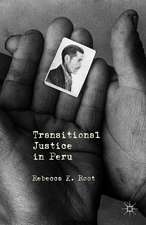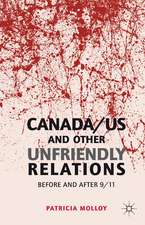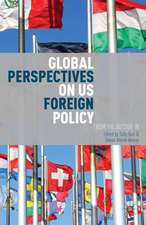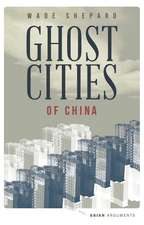Saudi Arabia and Iran: Friends or Foes?
Autor Banafsheh Keynoushen Limba Engleză Hardback – 5 feb 2016
| Toate formatele și edițiile | Preț | Express |
|---|---|---|
| Paperback (1) | 438.89 lei 3-5 săpt. | |
| Palgrave Macmillan US – 31 mar 2018 | 438.89 lei 3-5 săpt. | |
| Hardback (1) | 585.02 lei 3-5 săpt. | |
| Palgrave Macmillan US – 5 feb 2016 | 585.02 lei 3-5 săpt. |
Preț: 585.02 lei
Preț vechi: 635.89 lei
-8% Nou
Puncte Express: 878
Preț estimativ în valută:
111.95€ • 117.12$ • 92.99£
111.95€ • 117.12$ • 92.99£
Carte disponibilă
Livrare economică 12-26 martie
Preluare comenzi: 021 569.72.76
Specificații
ISBN-13: 9781137576279
ISBN-10: 1137576278
Pagini: 277
Ilustrații: XI, 277 p.
Dimensiuni: 140 x 216 x 18 mm
Greutate: 0.49 kg
Ediția:1st ed. 2016
Editura: Palgrave Macmillan US
Colecția Palgrave Macmillan
Locul publicării:New York, United States
ISBN-10: 1137576278
Pagini: 277
Ilustrații: XI, 277 p.
Dimensiuni: 140 x 216 x 18 mm
Greutate: 0.49 kg
Ediția:1st ed. 2016
Editura: Palgrave Macmillan US
Colecția Palgrave Macmillan
Locul publicării:New York, United States
Cuprins
Contents
Acknowledgements
Introduction
PART I
1. Overview of Saudi-Iranian Relations
2. How Religion Shaped the Saudi-Iranian Relations
PART II
3. Saudi Arabia and Iran in Early Twentieth Century
4. Early Diplomatic Relations
5. Diplomatic Relations: 1955–63
6. Epoch of Saudi Arabian-Iranian Cooperation and Rivalry
PART III
7. Saudi Arabia and Revolutionary Iran
8. Saudi-Iranian Détente
PART IV
9. Saudi Arabia's and Iran's Quest for Stability after 9/11
10. Saudi Arabia, Iran and Gulf Geopolitics: The Case of Iraq
11. Saudi Arabia, Iran, and Levant Geopolitics: The Cases of Lebanon, Syria, Palestine
Conclusion
Notes
Bibliography
Index
Acknowledgements
Introduction
PART I
1. Overview of Saudi-Iranian Relations
2. How Religion Shaped the Saudi-Iranian Relations
PART II
3. Saudi Arabia and Iran in Early Twentieth Century
4. Early Diplomatic Relations
5. Diplomatic Relations: 1955–63
6. Epoch of Saudi Arabian-Iranian Cooperation and Rivalry
PART III
7. Saudi Arabia and Revolutionary Iran
8. Saudi-Iranian Détente
PART IV
9. Saudi Arabia's and Iran's Quest for Stability after 9/11
10. Saudi Arabia, Iran and Gulf Geopolitics: The Case of Iraq
11. Saudi Arabia, Iran, and Levant Geopolitics: The Cases of Lebanon, Syria, Palestine
Conclusion
Notes
Bibliography
Index
Recenzii
From a Norwegian foreign affairs vantage point, where balancing a reputation as international peacemaker, giant oil producer, and close US ally is the main task, this book offers a refreshing view of the strategic importance of allowing Iran and Saudi Arabia to regain a balanced partnership in pursuit of security and lower ideological tensions. . . a carefully argued revelation.' – Tone Bleie, Professor, University of Tromsø, Norway, and Director of the International Research Group on Reintegration of Ex-Combatants (IRGR)
'Dr. Keynoush's book makes a timely intervention towards understanding the delicately poised Saudi-Iranian relationship. Extensively researched and historically nuanced in approach, it provides a much needed corrective to studies that view the rivalry between Saudi Arabia and Iran through the sectarian prism in the main. By foregrounding the role of external actors like the United States in the region, and the shifting logic of power politics, the analysiseffectively reframes a relationship that remains critical to the stability and security of the Persian Gulf region. A welcome addition to the literature on contemporary politics and international diplomacy, the book ought to be read by students and policy makers of the Middle East.' – Ayesha Jalal, Mary Richardson Professor of History and Director, Center for South Asian and Indian Ocean Studies, Tufts University, USA, and author of The Struggle for Pakistan: A Muslim Homeland and Global Politics
'Dr. Keynoush's book makes a timely intervention towards understanding the delicately poised Saudi-Iranian relationship. Extensively researched and historically nuanced in approach, it provides a much needed corrective to studies that view the rivalry between Saudi Arabia and Iran through the sectarian prism in the main. By foregrounding the role of external actors like the United States in the region, and the shifting logic of power politics, the analysiseffectively reframes a relationship that remains critical to the stability and security of the Persian Gulf region. A welcome addition to the literature on contemporary politics and international diplomacy, the book ought to be read by students and policy makers of the Middle East.' – Ayesha Jalal, Mary Richardson Professor of History and Director, Center for South Asian and Indian Ocean Studies, Tufts University, USA, and author of The Struggle for Pakistan: A Muslim Homeland and Global Politics
Notă biografică
Banafsheh Keynoush is a foreign affairs scholar and an advisor to American private sector companies and policy centers in the Middle East. She received her PhD at Tufts University, USA, and was a visiting fellow at the King Faisal Center for Islamic Studies and Research, Saudi Arabia. A former assistant professor, she writes and speaks extensively on the Middle East.
Textul de pe ultima copertă
In a riveting narrative based on accounts of her interactions with Saudi and Iranian politicians and rich archival material, a leading scholar on the Middle East unravels the mysteries of a contentious relationship. This seasoned observer of political and diplomatic worlds shatters the myth of the inevitability of sectarian conflict and that the diplomacy between Saudi Arabia and Iran is exhausted. Instead, Banafsheh Keynoush argues in Saudi Arabia and Iran: Friends or Foes? that it has yet to be explored, by recasting the partnership from a US-centered point of view to one based on how Saudi Arabia and Iran see their roles. Who is to blame and how to fix it is part of this penetrating historic account which captivates readers through accurate, non-sensational, and objective analysis. Keynoush recounts it all: the fears, misunderstandings, prejudices, and ambitions that have hobbled efforts to build a lasting partnership, creating a work that is important to both the expert and thelayperson.
















